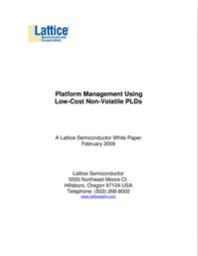Platform Management Using Low-Cost Non-Volatile PLDs
Power-up control, general purpose I/O expansion, voltage level translation and interface bridging are common functions in telecom infrastructure, server and industrial applications. System designers are turning to the use of programmable logic devices (PLDs) to implement these functions in their designs due to the inherent time-to-market and design flexibility advantages they offer over ASICs and ASSPs.
By using PLDs in their designs, designers can respond to changing market standards and requirements within a compressed window of opportunity.
Download this whitepaper to find out more.
Read More
By submitting this form you agree to Lattice Semiconductor Corporation contacting you with marketing-related emails or by telephone. You may unsubscribe at any time. Lattice Semiconductor Corporation web sites and communications are subject to their Privacy Notice.
By requesting this resource you agree to our terms of use. All data is protected by our Privacy Notice. If you have any further questions please email dataprotection@techpublishhub.com
Related Categories: Automotive, Communication, Components, Embedded, Industrial, Power, Switches

More resources from Lattice Semiconductor Corporation
POWER CONSIDERATIONS IN FPGA DESIGN
Power has always been a design consideration. Traditionally, though, a lower priority has been assigned to power than to most other variables (spee...
Solving Today’s Interface Challenges With Ultra-LowDensity FPGA Bridging Solutions
Designers are implementing a wide variety of interface bridging solutions that allow them to transfer data across protocols and, in the process, ex...
DESIGNING FOR LOW POWER
Power consumption is becoming an increasingly important variable when it comes to calculating OPEX and carbon footprint for telecom infrastructure ...
